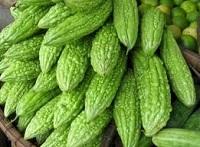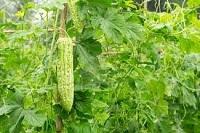Bitter Melon (苦瓜)
|
  | Momordica charantia often called bitter melon, bitter gourd or bitter squash in English, has many other local names. Goya from the indigenous language of Okinawa where there is a large US military presence and karavella from Sanskrit are also used by English-language speakers.
It is a tropical and subtropical vine of the family Cucurbitaceae, widely grown in Asia, Africa, and the Caribbean for its edible fruit, which is among the most bitter of all fruits[citation needed] . Its many varieties differ substantially in the shape and bitterness of the fruit. This is a plant of the tropics.Bitter melon originated in India, and it was carried to China in the 14th century.
DescriptionThis herbaceous, tendril-bearing vine grows to 5 m. It bears simple, alternate leaves 4–12 cm across, with three to seven deeply separated lobes. Each plant bears separate yellow male and female flowers. In the Northern Hemisphere, flowering occurs during June to July and fruiting during September to November.
The fruit has a distinct warty exterior and an oblong shape. It is hollow in cross-section, with a relatively thin layer of flesh surrounding a central seed cavity filled with large, flat seeds and pith. The fruit is most often eaten green, or as it is beginning to turn yellow. At this stage, the fruit's flesh is crunchy and watery in texture, similar to cucumber, chayote or green bell pepper, but bitter. The skin is tender and edible. Seeds and pith appear white in unripe fruits; they are not intensely bitter and can be removed before cooking.As the fruit ripens, the flesh (rind) becomes tougher, more bitter, and too distasteful to eat. On the other hand, the pith becomes sweet and intensely red; it can be eaten uncooked in this state, and is a popular ingredient in some Southeast Asian salads.
When the fruit is fully ripe, it turns orange and mushy, and splits into segments which curl back dramatically to expose seeds covered in bright red pulp.Varieties
Bitter melon comes in a variety of shapes and sizes. The Chinese variety is 20–30 cm long, oblong with bluntly tapering ends and pale green in color, with a gently undulating, warty surface. The bitter melon more typical of India has a narrower shape with pointed ends, and a surface covered with jagged, triangular "teeth" and ridges. It is green to white in color. Between these two extremes are any number of intermediate forms. Some bear miniature fruit of only 6–10 cm in length, which may be served individually as stuffed vegetables. These miniature fruit are popular in India and elsewhere in Southeast Asia.
Bitter melon is a significant ingredient in Okinawan cuisine, and is increasingly used in mainland Japan. It is popularly credited with Okinawan life expectancies being higher than the already long Japanese ones.
In Indonesia, bitter melon is prepared in various dishes, such as gado-gado, and also stir fried, cooked in coconut milk, or steamed.In Vietnam, raw bitter melon slices consumed with dried meat floss and bitter melon soup with shrimp are popular dishes. Bitter melons stuffed with ground pork are served as a popular summer soup in the south. It is also used as the main ingredient of "stewed bitter melon". This dish is usually cooked for the Tết holiday, where its "bitter" name is taken as a reminder of the poor living conditions experienced in the past.
In the Philippines, bitter melon may be stir-fried with ground beef and oyster sauce, or with eggs and diced tomato. The dish pinakbet, popular in the Ilocos region of Luzon, consists mainly of bitter melons, eggplant, okra, string beans, tomatoes, lima beans, and other various regional vegetables altogether stewed with a little bagoong-based stock.In Nepal, bitter melon is prepared as a fresh pickle called achar. For this, the bitter gourd is cut into cubes or slices and sautéed covered in oil and a sprinkle of water. When it is softened and reduced, it is minced in a mortar with a few cloves of garlic, salt and a red or green pepper. It is also sautéed to golden-brown, stuffed, or as a curry on its own or with potatoes.
In Trinidad and Tobago, bitter melons are usually sauteed with onion, garlic and scotch bonnet pepper until almost crisp.
Bitter melon has been used in various Asian and African herbal medicine systems for a long time.In Turkey, it has been used as a folk remedy for a variety of ailments, particularly stomach complaints.The fruit is broken up and soaked in either olive oil or honey.
Active substances
The plant contains several biologically active compounds, chiefly momordicin I and momordicin II, and cucurbitacin B. The plant also contains several bioactive glycosides (including momordin, charantin, charantosides, goyaglycosides, momordicosides) and other terpenoid compounds (including momordicin-28, momordicinin, momordicilin, momordenol, and momordol).It also contains cytotoxic (ribosome-inactivating) proteins such as momorcharin and momordin.
Anticancer
Two compounds extracted from bitter melon, α-eleostearic acid (from seeds) and 15,16-dihydroxy-α-eleostearic acid (from the fruit) have been found to induce apoptosis of leukemia cells in vitro. Diets containing 0.01% bitter melon oil (0.006% as α-eleostearic acid) were found to prevent azoxymethane-induced colon carcinogenesis in rats.Researchers at Saint Louis University claim an extract from bitter melon, commonly eaten and known as karela in India, causes a chain of events which helps to kill breast cancer cells and prevents them from multiplying.
Antihelmintic
Bitter melon is used as a folk medicine in Togo to treat gastrointestinal diseases, and extracts have shown activity in vitro against the nematode worm Caenorhabditis elegans.
Antimalarial
Bitter melon is traditionally regarded in Asia as useful for preventing and treating malaria.[citation needed] Tea from its leaves is used for this purpose also in Panama and Colombia. In Guyana, bitter melons are boiled and stir-fried with garlic and onions. This popular side dish known as corilla is served to prevent malaria. Laboratory studies have confirmed that species related to bitter melon have antimalarial activity, though human studies have not yet been published.
Antiviral
In Togo, the plant is traditionally used against viral diseases such as chickenpox and measles. Tests with leaf extracts have shown in vitro activity against the herpes simplex type 1 virus, apparently due to unidentified compounds other than the momordicins.
Laboratory tests suggest compounds in bitter melon might be effective for treating HIV infection.As most compounds isolated from bitter melon that impact HIV have either been proteins or lectins, neither of which are well-absorbed, it is unlikely that oral intake of bitter melon will slow HIV in infected people. Oral ingestion of bitter melon possibly could offset negative effects of anti-HIV drugs, if an in vitro study can be shown to be applicable to people.
Cardioprotective
Studies in mice indicate bitter melon seed may have a cardioprotective effect by down-regulating the NF-κB inflammatory pathway.
Diabetes
In 1962, Lolitkar and Rao extracted from the plant a substance, which they called charantin, which had hypoglycaemic effect on normal and diabetic rabbits. Another principle, active only on diabetic rabbits, was isolated by Visarata and Ungsurungsie in 1981.Bitter melon has been found to increase insulin sensitivity. In 2007, a study by the Philippine Department of Health determined a daily dose of 100 mg per kilogram of body weight is comparable to 2.5 mg/kg of the antidiabetes drug glibenclamide taken twice per day. Tablets of bitter melon extract are sold in the Philippines as a food supplement and exported to many countries.
Other compounds in bitter melon have been found to activate the AMPK, the protein that regulates glucose uptake (a process which is impaired in diabetics).
Bitter melon also contains a lectin that has insulin-like activity due to its nonprotein-specific linking together to insulin receptors. This lectin lowers blood glucose concentrations by acting on peripheral tissues and, similar to insulin's effects in the brain, suppressing appetite. This lectin is likely a major contributor to the hypoglycemic effect that develops after eating bitter melon.[citation needed] As bitter melon is extremely bitter if eaten raw, it must be cooked to make it palatable. A simple recipe for bitter melon can help diabetics.
Weight loss
In combination with Chinese yam, bitter melon has been shown to contribute to weight loss. Over a period of 23 weeks, those eating the diet containing bitter melon lost 7 kilos.
Other uses
Bitter melon has been used in traditional medicine for several other ailments, including dysentery, colic, fevers, burns, painful menstruation, scabies and other skin problems. It has also been used as abortificant, for birth control, and to help childbirth.
Cautions
The seeds of bitter melon contains vicine, so can trigger symptoms of favism in susceptible individuals. In addition, the red arils of the seeds are reported to be toxic to children, and the fruit is contraindicated during pregnancy.
|
|